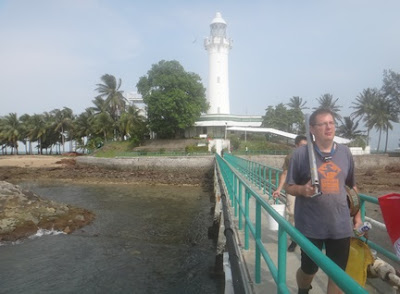Another predawn trip, this time to magical Raffles Lighthouse. On the horizon, Pulau Senang and the tiny Pulau Biola which lies in the restricted Life Firing Area.
Ominous
dark clouds gathered as the team worked the rocky shore in the outgoing
tide. But we had a great survey on this amazingly reefy shore.
We moved over to the more sheltered lagoon when the winds rose. Fortunately, we didn't get any rain in the end.
Just under the jetty, there is an amazing variety of corals. Prof Daphne as usual, is on the lookout for anemones.
In daylight, the richly covered reef is revealed. Dr Zeehan is working carefully among the corals to catch reef fishes.
We surveyed the reef right to the edge.
The ground is thickly covered in corals of all kinds!
Here's a closer look at a typical part of the small lagoon.
One of the special corals that can be found abundantly at Raffles Lighthouse is the pretty orange cave coral.
As it got hot, I took hid in the shade under the jetty, where there is MORE corals.
A look at the eastern shore of Raffles Lighthouse with Pulau Biola on the horizon.
Amazing branching corals are abundant here. These corals are very
delicate and we are careful not to damage them or any other corals.
Among my favourite finds was this abalone. Yes, Singapore does have
wild abalones. They are small and hard to spot. I couldn't pry it off
the small rock it was clinging to so I brought back the entire rock.
When we got to Base Camp, I couldn't find it on the rock. It had crawled
onto another rock in the sampling bucket! Thankfully Prof Daphne found
it.
Another of my favourite finds was this pretty brittle star.
There were also two small Fluted giant clams in the lagoon!
As
the tide rushed back into the lagoon, we left Raffles Lightouse. Here's
Dr Arthur with the 'yabby pump', a way to gently remove critters from
their burrows. It would otherwise be very difficult to get them out.
When
we got back, everyone was intrigued by the wide variety of fishes that
Dr Zeehan had collected. Teams also visited Cyrene and Pulau Jong today.
Chandi was also back at the Base Camp with her video man to film the goings on.
As
I left in the afternoon, the ladies of the Expedition were hauling back
heavy metal frames to be used for the beam trawl in the dredge. These
were damaged in the recent dredge surveys.
As
I got back to Base Camp in the evening, I noticed some surveying has
been going on the lagoon nearby. The Expedition never stops surveying!
The
dredge today was successful and full of interesting critters. To get
the special specimens, lots of dredge material have to be painstakingly
sieved.
Then it takes patience to pick out all the important specimens. From delicate sea fans, to lots of bryozoans and more!
Dr Len McKenzie of Seagrass-Watch has recently arrived and took samples of seagrasses from Cyrene.
The
ladies at the preservation station are constantly at work. They
actually have a graveyard shift and the station runs 24/7 and still can
barely keep up with the steady stream of specimens.
The gentlemen photographers are hard at work, fueled by copious amounts of snacks at hand.
This morning, the
Expedition members are thrilled to read all about the Southern
Expedition and Mega Marine Survey in the papers today, both Chinese and
English. Some media articles are compiled on wildsingapore news.
Today,
the Expedition was treated to fresh rambutans and mangosteens. They
were much appreciated, especially by our participants from overseas. Now
we wonder if we should introduce them to durians?
In a few hours, we head out for yet more morning trips!
During the Expedition, I will try to post live updates on twitter as well as to facebook and the Mega Marine Survey facebook page.
These will get less frequent as I start to do field work. I'm not
very good at the smart phone in the field, and also, phone
connections are not always strong enough to post regularly. So also
check out tweets by participants using the hashtag for the Survey
#MegaMarine. These are consolidated on the Mega Marine Survey blog.
Volunteer sign up for the Southern Expedition are already closed due
to limited places and early logistical arrangements needed for
participation.
But no worries, you CAN still join the Survey! Lots of surveys will
continue after the Expedition, just at a less frenzied rate. There
will be lots of other opportunities for volunteers to
participate in dredging, field surveys as well as laboratory
sessions. To join the Mega Marine Survey, register your
interest in this form
and you'll be invited to join the mailing list to receive
updates on the Survey and sign up for Survey activities. Also
check out the FAQs for more about the Survey.


























No comments:
Post a Comment